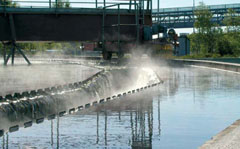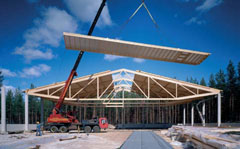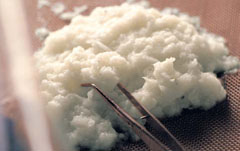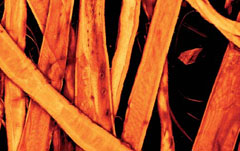| Cell wall structure
The structure of the cell wall and its biosynthesis is known fairly well. The initial deposition of cellulose microfibrils and hemicelluloses is followed by delignification that leads to the formation of a nanostructured composite. The tensile strength of the composite is given solely by the cellulose microfibrils while the water-containing matrix of hemicelluloses and lignin acts as a lubricating medium between the microfibrils and makes the cell wall tough. The bulk of the cellulose microfibrils are located nearly axially oriented in the S2-layer giving the wood fibres a high tensile stiffness. The transverse stiffness of the fibres is brought by the S1- and S3-layers in which the cellulose microfibrils are spun close to perpendicularly to the main fibre axis. Adjacent wood fibres are glued together by lignin.
Our recent observations suggest that the web strength (toughness) of sheets made of chemical wood pulps is affected by the strength of the S1-layer. The thin surface microfibrils are more vulnerable under the harsh pulping conditions than the thicker microfibrils in the S2-layer. Because the cross section of most wood fibres is rather rectangular than circular, the surface microfibrils are deeply curved in the cell corners. We hypothesize that in the cell corner cellulose is less crystalline than elsewhere in the cell wall.
The focus of this part of the research is to get deeper understanding on the structure of the P- and S1-layers of wood fibres. The theme is relevant for understanding the mechanisms of defibration processes, the strength of wood fibres and webs made of them and reactivity of cellulose fibres in chemical processes like manufacturing of soluble cellulose derivatives. Because the P- and S1-layers are thin (0.1-0.5 µm) special analytical techniques are needed to get this resolution. We will apply AFM-Raman and ATR-Raman techniques to investigate surfaces and cross sections of wood and pulp fibres. A new AFM-Raman instrument will be purchased with a partial funding from TKK's Centre for New Materials. An ATR-Raman cell will be developed in collaboration with the Metrology Research Institute (TKK and MIKES).
Aging phenomena of wood and their prevention In indoor applications naturally lightly colored wood is darkened with time when exposed to light. In outdoor applications both dark and light unprotected wood surfaces finally get a characteristic gray color. Bleached printing papers made of mechanical wood pulps are rapidly yellowed in sunlight.
The origin of light-induced discoloring of wood is known in many details. Lignin phenols are converted into quinones by the action of oxygen in the atmosphere. The ultraviolet radiation of sun or manmade light sources catalyzes the oxidation. Hydrogen peroxide is formed as an intermediate that is able to further oxidize the quinones into muconic acid type structures. The increase in the hydrophilicity of lignin leads to its leaching by rain. The removal of lignin enables also dissolution of hemicelluloses by water.
The fragmentation of lignin weakens the native interfiber bonding. Microscale cracks are formed on the wood surfaces by the action of varying atmospheric humidity and temperature and finally single “bleached” fibers are liberated.
Several treatments have been suggested to protect wood or wood fibers against the discoloring phenomenon. The treatments include blocking of ultraviolet light with thin protecting films of UV absorbing materials, use of organic radical scavengers and blocking of the free phenols with ether or ester groups. Most of the treatments are unrealistically costly to apply industrially.
The proposed work aims at developing a method that could be industrially applied for protection of wood or wood pulps against aging. The basics mechanisms that will be studied include blocking of phenolic lignin structures through etherification and reduction of the carbonyl content of lignin by various strategies.
The research theme is especially relevant because of the set target to make wood as the most important European construction material by 2010. Through the surface modification the color stability of wood and the durability of surface treated wooden composites could be increased. The theme is also important in developing demanding applications for printing and packaging products, including composites, made of lignin containing wood fibres.
| 





